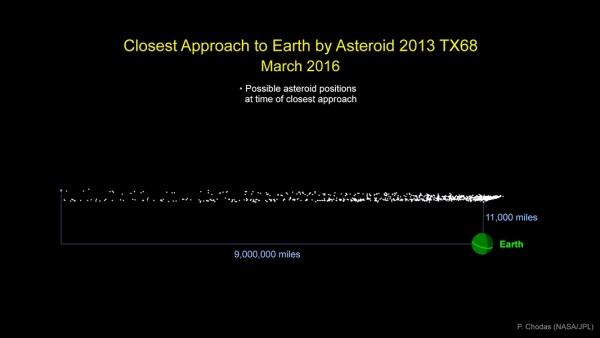By Ana Verayo, | February 04, 2016

Graphic indicates the cloud of possible locations asteroid 2013 TX68 will be in at the time of its closest approach to Earth during its safe flyby of our planet on March 5.
A small asteroid will be zooming dangerously near Earth on March 5, confirm scientists from NASA's Near Earth Objects (NEOs) Studies in California. This approaching asteroid already did a flyby past the planet at a safe distance two years ago, however, this upcoming trajectory will be closer than ever, from 14 million kilometers to just 17,000 kilometers.
Like Us on Facebook
NASA says that it is impossible for the asteroid to impact Earth in March but there will be a remote possibility that Asteroid 2013 TX68 will hit the planet on September 28, 2017. Scientists say that the odds will be one to 250 million.
According to manager of NASA's Center for NEO Studies, Paul Chodas, the possible collision of any of these flyby dates are too small to be concerned about, adding that future observations can even further reduce the probabilities even more.
With this in mind, NASA also just launched a new planetary defense system that focuses on protecting the planet from dangerous asteroids and objects that can potentially hit the surface of the planet.
NASA's Planetary Defense Coordination Office aims to synchronize all efforts to immediately respond to life threatening near Earth objects and will also monitor other NASA branches to identify and describe asteroids and comets that come zipping by Earth's orbit.
Asteroid 2013 TX68 is 100 feet in diameter and if it ever enters Earth's atmosphere, it can produce an air burst with energies twice as the Chelyabinsk asteroid event in Russia some three years ago. The asteroid was broken up upon entry in Russia where it injured around 1,200 people in Chelyabinsk.
The NASA-funded Catalina Sky Survey discovered asteroid 2013 TX68 on October 2013, where it approached the planet on its night time side. Scientists monitored it for three days, as it passed by the daytime sky where it could no longer be detected.
Since the asteroid was not monitored intensively for a long period of time, astronomers cannot predict its precise orbit around the sun, however, scientists confirm that it will not impact Earth during its flyby next month.
Chodas adds that since the orbit is quite uncertain, it will be challenging to know where the asteroid is exactly right now. The team is also certain that other asteroid hunting telescopes can aid in detecting it when it safely passes the planet next month, along with more data about its orbit around the sun.
-
Use of Coronavirus Pandemic Drones Raises Privacy Concerns: Drones Spread Fear, Local Officials Say

-
Coronavirus Hampers The Delivery Of Lockheed Martin F-35 Stealth Fighters For 2020

-
Instagram Speeds Up Plans to Add Account Memorialization Feature Due to COVID-19 Deaths

-
NASA: Perseverance Plans to Bring 'Mars Rock' to Earth in 2031

-
600 Dead And 3,000 In The Hospital as Iranians Believed Drinking High-Concentrations of Alcohol Can Cure The Coronavirus

-
600 Dead And 3,000 In The Hospital as Iranians Believed Drinking High-Concentrations of Alcohol Can Cure The Coronavirus

-
COVID-19: Doctors, Nurses Use Virtual Reality to Learn New Skills in Treating Coronavirus Patients







